
Fitchburg is a city in northern Worcester County, Massachusetts, United States. The third-largest city in the county, its population was 41,946 at the 2020 census. Fitchburg is home to Fitchburg State University as well as 17 public and private elementary and high schools.
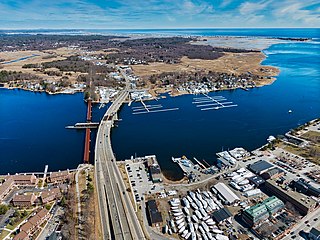
The Merrimack River is a 117-mile-long (188 km) river in the northeastern United States. It rises at the confluence of the Pemigewasset and Winnipesaukee rivers in Franklin, New Hampshire, flows southward into Massachusetts, and then flows northeast until it empties into the Gulf of Maine at Newburyport. From Pawtucket Falls in Lowell, Massachusetts, onward, the Massachusetts–New Hampshire border is roughly calculated as the line three miles north of the river.

Groton is a town in northwestern Middlesex County, Massachusetts, United States, within the Greater Boston metropolitan area. The population was 11,315 at the 2020 census. It is home to two prep schools: Lawrence Academy at Groton, founded in 1792 and the third-oldest private school in Massachusetts; and Groton School, founded in 1884.
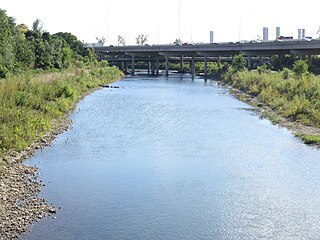
The Olentangy River is a 97-mile-long (156 km) tributary of the Scioto River in Ohio, United States.

North Station is a commuter rail and intercity rail terminal station in Boston, Massachusetts. It is served by four MBTA Commuter Rail lines – the Fitchburg Line, Haverhill Line, Lowell Line, and Newburyport/Rockport Line – and the Amtrak Downeaster intercity service. The concourse is located under the TD Garden arena, with the platforms extending north towards drawbridges over the Charles River. The eponymous subway station, served by the Green Line and Orange Line, is connected to the concourse with an underground passageway.
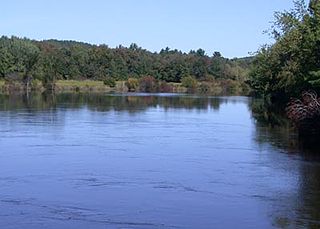
The Nashua River, 37.5 miles (60.4 km) long, is a tributary of the Merrimack River in Massachusetts and New Hampshire in the United States. It is formed in eastern Worcester County, Massachusetts, at the confluence of the North Nashua River and South Nashua River, and flows generally north-northeast past Groton to join the Merrimack at Nashua, New Hampshire. The Nashua River watershed occupies a major portion of north-central Massachusetts and a much smaller portion of southern New Hampshire.
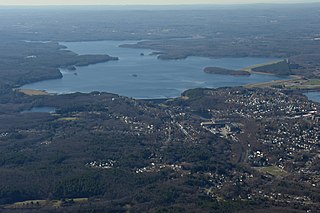
The Wachusett Reservoir is the second largest body of water in the state of Massachusetts. It is located in central Massachusetts, northeast of Worcester. It is part of the water supply system for metropolitan Boston maintained by the Massachusetts Water Resources Authority (MWRA). It has an aggregate capacity of 65 billion US gallons (250,000,000 m3) and an area of almost 7 square miles (18 km2). Water from the reservoir flows to the covered Norumbega Storage Facility via the Cosgrove Tunnel and the MetroWest Water Supply Tunnel. The reservoir has a maximum depth of 120 feet (37 m) and a mean depth of 48 feet (15 m).
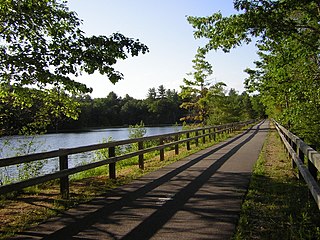
The Nashua River Rail Trail is a 12.5-mile (20.1 km) paved mixed-use rail trail in northern Massachusetts and southern New Hampshire under control of the Massachusetts Department of Conservation and Recreation (DCR). It roughly follows the course of the Nashua River, passing through the towns of Ayer, Groton, Pepperell, and Dunstable, Massachusetts and ends about a mile across the New Hampshire state border in Nashua, New Hampshire. The trail is used by walkers, cyclists, inline skaters, equestrians, and cross-country skiers.
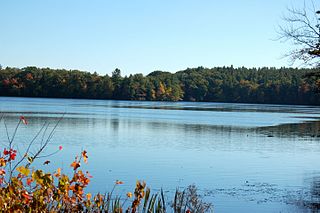
The Quinapoxet River is part of the Nashua River watershed in northern Massachusetts in the United States. It is part of the Massachusetts Water Resources Authority water system supplying drinking water to the greater Boston area.
Barzillai Lew was an African-American soldier who served with distinction during the American Revolutionary War.

Ayer station is an MBTA Commuter Rail station located off Main Street in the Ayer Main Street Historic District of Ayer, Massachusetts. It serves the Fitchburg Line. There are three tracks through the station, two of which are served by a pair of low-level side platforms, which are not accessible. There is a shelter on the inbound platform.

North Leominster station is an MBTA Commuter Rail station in Leominster, Massachusetts. It serves the Fitchburg Line. It is located at 34 Nashua Street, east of Main Street. The station, which is accessible, has two side platforms to serve the line's two tracks. There is a small freight yard adjacent to the parking lot and mainline tracks on the south end of the inbound platform. A garage opened in 2014 to nearly triple parking capacity at the station, which serves as a park-and-ride stop for Route 2 and I-190, to a total of 436 spaces.
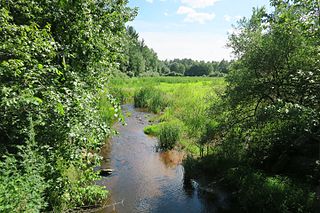
Wekepeke is the name of an aquifer and brook in Sterling, Massachusetts, United States. The aquifer has a land surface area of 11.5 square miles (30 km2).
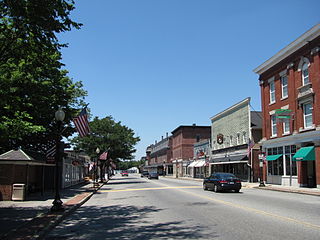
Ayer is a town in Middlesex County, Massachusetts, United States. Originally part of Groton, it was incorporated February 14, 1871, and became a major commercial railroad junction. The town was home to Camp Stevens, a training camp for Massachusetts volunteers during the American Civil War. Later, Fort Devens was established by the federal government to train New England soldiers for World War I. Fort Devens is a major influence on the area, although it is considerably smaller than when it was first closed in the mid-1990s. The town's population was 8,479 at the 2020 census.

Pepperell is a town in Middlesex County, Massachusetts, United States. The population was 11,604 at the 2020 census. It includes the village of East Pepperell.
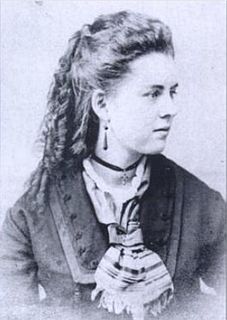
Ella Augusta "Eleanor" Norcross was an American painter who studied under William Merritt Chase and Alfred Stevens. She lived the majority of her adult life in Paris, France, as an artist and collector and spent the summers in her hometown of Fitchburg, Massachusetts. Norcross painted Impressionist portraits and still lifes, and is better known for her paintings of genteel interiors.
Lynn Henning is a farmer and environmentalist from Michigan, United States. She was awarded the Goldman Environmental Prize in 2010 for her focus on water quality and for fighting pollution from concentrated animal feeding facilities. She exposed the polluting practices of livestock factory farms in rural Michigan, gaining the attention of the federal EPA and prompting state regulators to issue hundreds of citations for water quality violations. Henning currently works for the Socially Responsible Agricultural Project (SRAP). She also won the Planet Defender Award 2012 for her advocacy and her work.
Friends of the Everglades is a conservationist and activist organization in the United States whose mission is to "preserve, protect, and restore the only Everglades in the world." The book Biosphere 2000: Protecting Our Global Environment refers to Friends of the Everglades as an organization that has fought to preserve North America's only subtropical wetland.

Deepika Kurup is an inventor, scientist, and clean water advocate. She is the recipient of the 2012 Discovery Education 3M Young Scientist Award. Kurup was awarded the $25,000 Award for her work in developing a new and inexpensive method to clean water using solar power. She also a finalist in the 2014 international Stockholm Junior Water Prize with her project "A Novel Photocatalytic Pervious Composite for Degrading Organics and Inactivating Bacteria in Wastewater."
Mrs. David Wright's Guard was an all-woman militia raised by the Patriots in Massachusetts during the American Revolutionary War. The Guard were an armed force of 30 to 40 women who guarded the Nashua River crossings to prevent the movement of Loyalist couriers.















